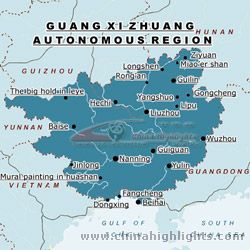Guilin Facts
One of the better known tourist destinations of Southern China, and indeed the whole of China, Guilin, which is a name that literally means Sweet Osmanthus, is a prefectural city that has a tourism sector driven by one of the best sights in the entire world, the Li River.
With a very rich plant life that embodies far more than the dominant Sweet Osmanthus, Guilin is a region of Southern China which is sectioned off from main China by some naturally occurring boundaries, including the Nan Mountains, accounting for the logic behind its prefectural administrative status but this bodes very well for the tourism industry of the region.
About a dozen small ethnic groups call Guilin home, which is part of the Guangxi autonomous region, with the Zhuang ethnic group dominating.
Guilin is one of the three largest of the Guangxi region, coming in at number three, behind Nanning and Liuzhou.
Quick Facts
- Chinese Name:桂林
- Chinese Pinyin: Guilin
- Location:South china
- Latitude:25° 16' N
- Longitude:110° 17' E
- Area Code:0773
- Time Zone:(UTC+8)
- Population:850,000
Location
 Guilin is located 109°E longitude and 24° N latitude in the northeast of Guangxi Zhuang Autonomous Region. The Guilin Government area covers an area of 4,195 square kilometers. It is in a basin surrounded by the Yuecheng Range, Ocean Hill, Jiaqiao Range and Tianping Hill. Guilin is located almost due west of Hong Kong and about 1 hour by air.
Guilin is located 109°E longitude and 24° N latitude in the northeast of Guangxi Zhuang Autonomous Region. The Guilin Government area covers an area of 4,195 square kilometers. It is in a basin surrounded by the Yuecheng Range, Ocean Hill, Jiaqiao Range and Tianping Hill. Guilin is located almost due west of Hong Kong and about 1 hour by air.
The Li River meanders through Guilin from north to south. Most of Guilin lies on the western bank of the Li River.
The main artery is Zhongshan Lu, which runs roughly parallel to the river on its western side. At the southern end of this street is Guilin Railway Station. Zhoangshan Lu is a rapidly developing stretch of tourist class hotels and retail shops.
The city center is dominated by the central square which is surrounded by a number of good hotels, shopping precincts and commercial buildings.
Guilin is built around its two rivers and lakes that are inter-connected. Many distinctive bridges crisscross the waterways.
Those who enjoy walking can spend many hours wandering the beautiful river and lakes make Guilin what it is.
Guilin Geographical Characteristics
The topography of Guilin is some of the most unique known to the world, with something to amaze the eye with just about every corner one turns.
The Li River, which is widely dubbed to be the soul of Guilin, exists as the radial focal point of all the majestic views to be savored, in and around Guilin, with the pick of the views arguably being the Karsts.
The Karsts of Guilin are simply magical land formations, which represent a unique set of mountains or hills, which are rounded in nature and seem as if they are mounds which have burst right through the earth's surface. It truly is a magical site to behold and one can spend hours and hours on end, just staring up into the sky, tracing the strange yet beautiful outlines of the Karsts.
During different times of the day, the land formations seem to display human-like character, constantly chopping and changing, largely due to how they appear on the back of the weather conditions. Guilin Karsts under fog are totally different to how they appear in direct sunlight, giving the optical illusion of a constantly changing topography.
Karst caves and stone forests are a feature the natural environment of Guilin . The most typical cave is Reed Flute Cave which is most representative of this area. The altitude is 140-160 meters. Guilin is in subtropical and monsoon zone with warm and moist climate. All this makes Guilin a unique natural experience for the visitor.
The Karsts aren't the only attractions though and make up just a fraction of the majestic sights offered by Guilin's Li River area, which stretches out into the city, characterized by meandering bits of the river, farms, rice paddies and some very green surroundings. Naturally this type of land arrangement and greenery makes for a great habitat for exotic animal life, which co-exists with the farmers littering parts of the area.
An encounter with a buffalo or two is a very real possibility, complemented by some tamed cormorants as part of a very diverse bird life, but the Karsts simply take the attention, often appearing as surreal, making for a great moment in time that screams to be captured in a photograph, video or painting.
Karst Mountains and Caves in Guilin
The Karst Mountains and caves in Guilin are one of the few places on earth that displays the beauty of huge, naturally forged Karst hills and caves. The hills and caves have been an ancient attraction with some inscriptions on its walls dated 729 AD in the Tang Dynasty. The beauty of the place and its imposing structures made this an almost spiritual place to visit and experience. Today, thousands of people visit the site each year and attracting thousands more as the news of its beauty is being spread all over the world.
Guilin History
In looking at the history of Guilin, the limestone protrusions (Karsts) give evidence of the fact that a large part of the area was completely submerged under the ocean, gradually rising over thousands of years to form what is today known as the prefectural region of Guilin.
As far as the history of man in Guilin goes, settlements go as far back as 310 to 314 BC, with these early settlers drawn to the Li River banks. Formal documentation of the city goes on to a period of about 200 years later than this first settlement, during the Han Dynasty, which saw the establishment of the Shi An County.
The city then went through a period of identity redefinition, renamed Guizhou around 507 AD, after which it became Guilin in 1940.
With such an extensive history, encompassing politics, land formations and human development, together with the sheer beauty of the city, make Guilin what it is today, one of the world's preferred tourist destinations, simply because of the sightseeing alone. Naturally, this spills over into other surrounding driving factors of the tourism sector.
Demographics
Like many other areas of even Central China, Guilin is a very densely populated region, largely due to a large influx of long-haul tourists, but also generically. Guilin covers 27 809 square kilometres which is a surface area that houses over 4.7 million residents. A variety of living conditions and lifestyles is evident throughout the region, which is to be expected, given the extensive history and different ethnicities in the area.
As far as the languages go, diversity doesn't even begin to explain how an area such as Guilin can have so many different languages and dialects of Chinese and Mandarin.
Guilin languages include Mandarin, Zhuang languages, Cantonese, Mienic languages,the Lakkja language, Chinese, Vietnamese, Mandarin Chinese, Mandarin, Arabic, Dungan, other Chinese dialects, Miao and Dong, which makes for a cocktail of different cultures and ways of life, mixed in with a great tourist inclination, so languages like English make their way into the mix, if only to serve the booming tourism market.
Recommended Tours
Got questions? Ask us here!
Sally Guo
Travel Advisor



